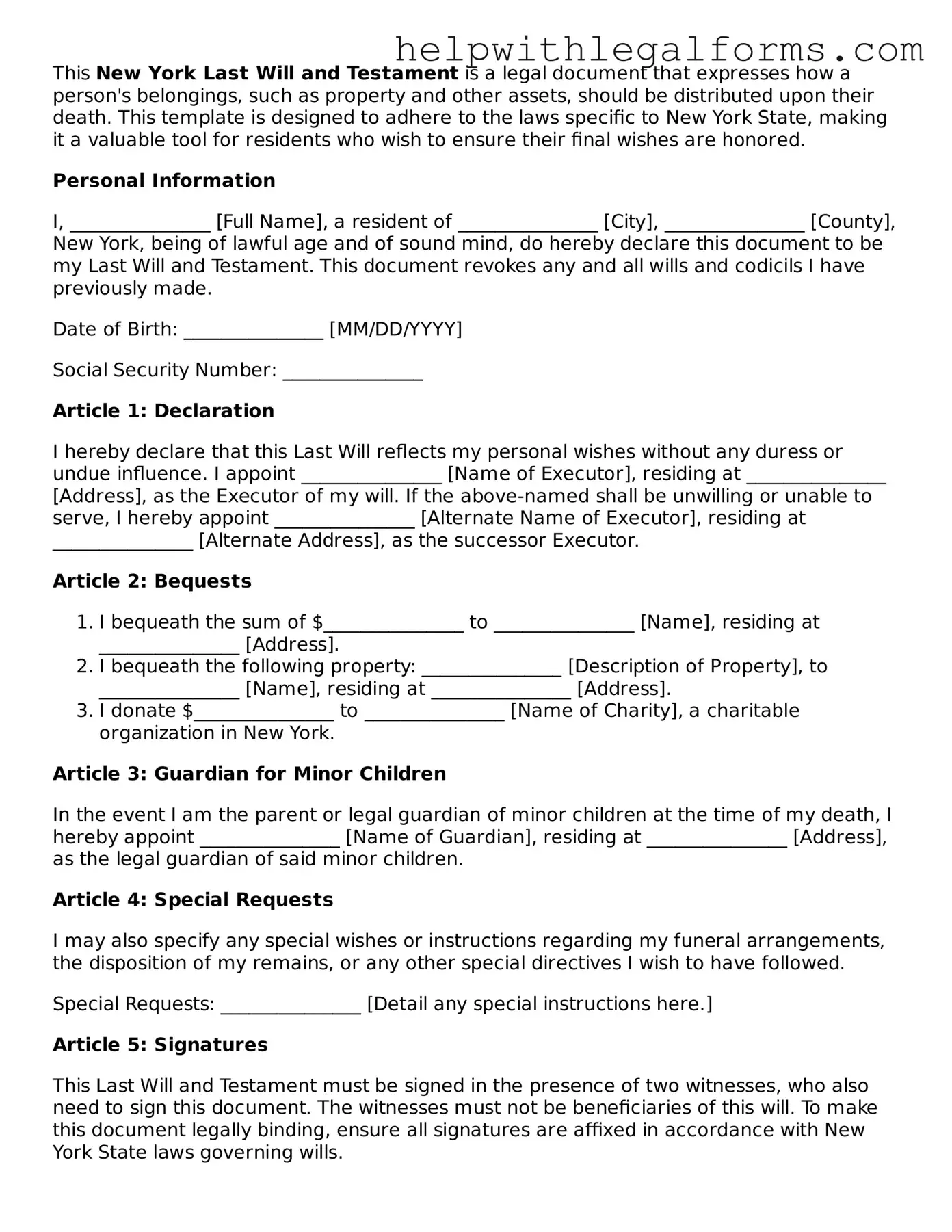This New York Last Will and Testament is a legal document that expresses how a person's belongings, such as property and other assets, should be distributed upon their death. This template is designed to adhere to the laws specific to New York State, making it a valuable tool for residents who wish to ensure their final wishes are honored.
Personal Information
I, _______________ [Full Name], a resident of _______________ [City], _______________ [County], New York, being of lawful age and of sound mind, do hereby declare this document to be my Last Will and Testament. This document revokes any and all wills and codicils I have previously made.
Date of Birth: _______________ [MM/DD/YYYY]
Social Security Number: _______________
Article 1: Declaration
I hereby declare that this Last Will reflects my personal wishes without any duress or undue influence. I appoint _______________ [Name of Executor], residing at _______________ [Address], as the Executor of my will. If the above-named shall be unwilling or unable to serve, I hereby appoint _______________ [Alternate Name of Executor], residing at _______________ [Alternate Address], as the successor Executor.
Article 2: Bequests
- I bequeath the sum of $_______________ to _______________ [Name], residing at _______________ [Address].
- I bequeath the following property: _______________ [Description of Property], to _______________ [Name], residing at _______________ [Address].
- I donate $_______________ to _______________ [Name of Charity], a charitable organization in New York.
Article 3: Guardian for Minor Children
In the event I am the parent or legal guardian of minor children at the time of my death, I hereby appoint _______________ [Name of Guardian], residing at _______________ [Address], as the legal guardian of said minor children.
Article 4: Special Requests
I may also specify any special wishes or instructions regarding my funeral arrangements, the disposition of my remains, or any other special directives I wish to have followed.
Special Requests: _______________ [Detail any special instructions here.]
Article 5: Signatures
This Last Will and Testament must be signed in the presence of two witnesses, who also need to sign this document. The witnesses must not be beneficiaries of this will. To make this document legally binding, ensure all signatures are affixed in accordance with New York State laws governing wills.
Signature of Testator: _______________
Date: _______________ [MM/DD/YYYY]
Witness 1 Signature: _______________
Witness 1 Printed Name: _______________
Witness 1 Address: _______________
Witness 2 Signature: _______________
Witness 2 Printed Name: _______________
Witness 2 Address: _______________
Article 6: Declaration of Witnesses
We, the undersigned, declare that the testator, _______________ [Full Name of Testator], sign their name to this instrument, willingly and as a free act and deed, in our presence and in the presence of each other. The testator declared the instrument to be their Last Will and Testament in our presence, who, at the testator's request and in the testator's presence, and in the presence of each other, have signed our names as witnesses. We understand this will is executed in accordance with the laws of New York State, and we are of sufficient age to witness a will and are not named as beneficiaries in this will.
Witness 1 Date: _______________ [MM/DD/YYYY]
Witness 2 Date: _______________ [MM/DD/YYYY]
